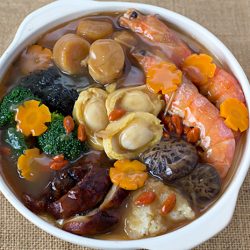Pen Cai (盆菜)
Pen Cai (Poon Choi/Pen Chai/Peng Cai/Big Bowl Feast) literally means “basin vegetables” (盆菜) as it was traditionally served to the Emperor in wooden washbasins during the Song Dynasty (adapted to claypot or casserole in modern times).
See Also:
It is a traditional one-pot Chinese dish of Cantonese origin, and have been a very popular dish in Hong Kong. In recent years, the dish gained immense popularity as a Chinese New Year dish in Singapore. A distinctive feature of Pen Chai is that the ingredients in the claypot are cooked separately, layered and topped with an assortment of seafood delicacies fit for royalty (with luxurious seafood such as abalone and scallops). Eating pen cai signifies abundance and richness in the coming year. I made this pen cai on Sunday for my family’s early Chinese New Year reunion dinner as I will be away during the festive season and I’m happy that it was well-received on the dinner table!
Auspicious symbolisms of Pen Cai ingredients:
- Fat choy (dried moss) sounds like “fatt choi” (striking it rich)
- Prawns (sounds like “ha” in Cantonese) symbolizing laughter (笑 “哈哈”) and happiness
- Green ingredients (broccoli): 青春常驻 (perpetual youthfulness)
- Red items (carrot and wolfberries): 鸿运当头 (good fortune)
- White radish (daikon): 风生水起/步步高升(increasing growth & prosperity)
- Abalone: 年年’包’有余 (increasing abundance). They also looked like ingots (ancient China currency symbolising wealth)
- Golden ingredients (scallops, tau kee, fish maw, tau kwa): 翩地黄金 (abundant wealth)
- Carrots cut to flower shapes: 花开富贵 (blooming success).
Step-by-Step Photos (How to layer the ingredients)
Here’s a step-by-step on how I layer my casserole of treasures. The bottom ingredients are those which can absorb the braising sauce most efficiently. The top layer are the luxury and auspicious items.
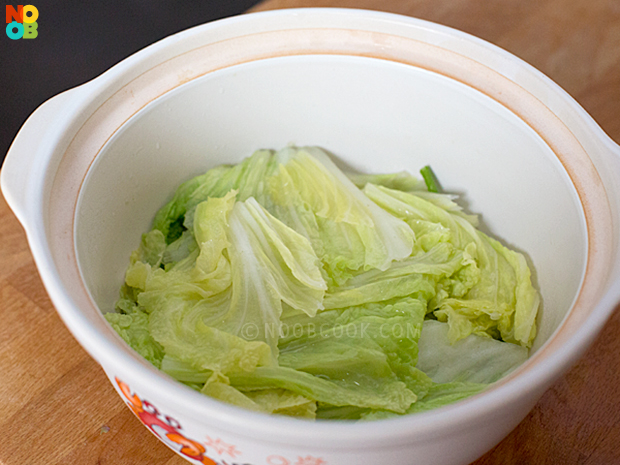
Layer 1: Napa cabbage

Layer 2: Tau kee (beancurd skin)
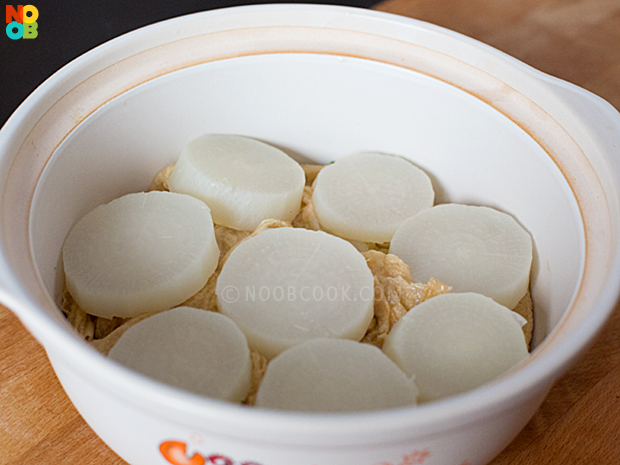
Layer 3: Daikon (white radish)
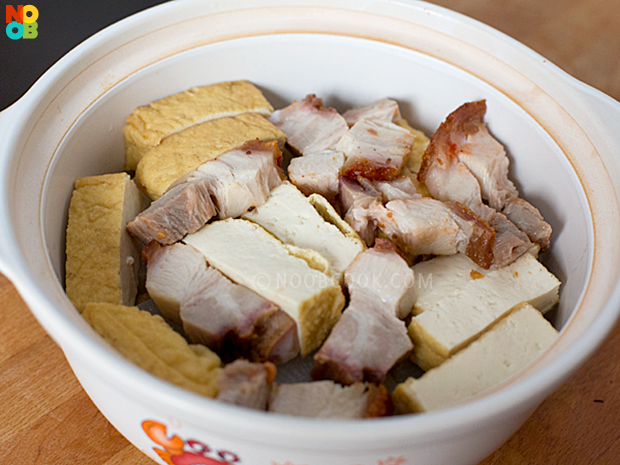
Layer 4: Tau kwa & siu yok
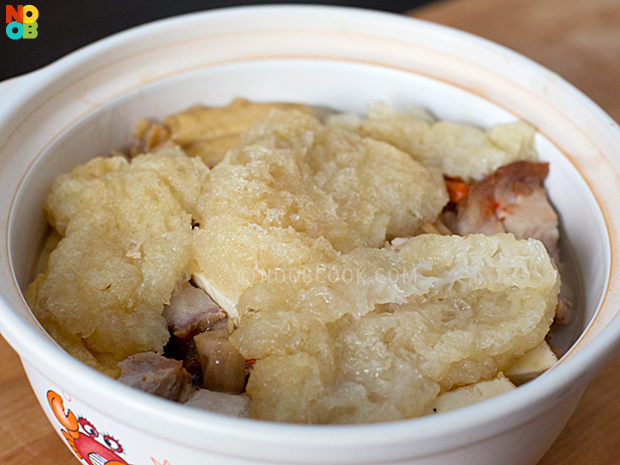
Layer 5: Fish maw (3/4 of it)
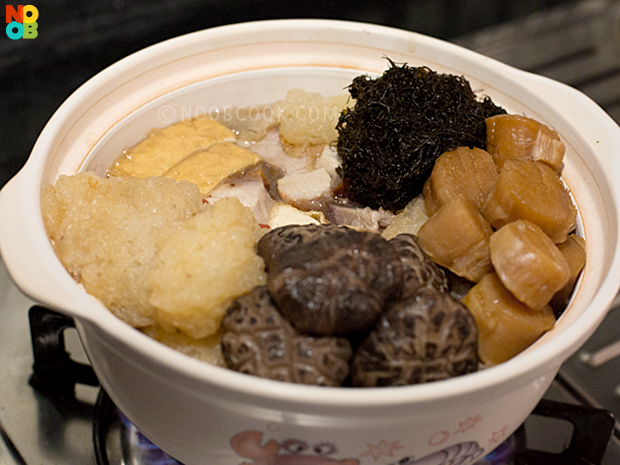
Layer 6: Fat choy, scallops, mushrooms & remaining fish maw. Add gravy until just before the top layer. Cover with lid and simmer for 10 minutes.
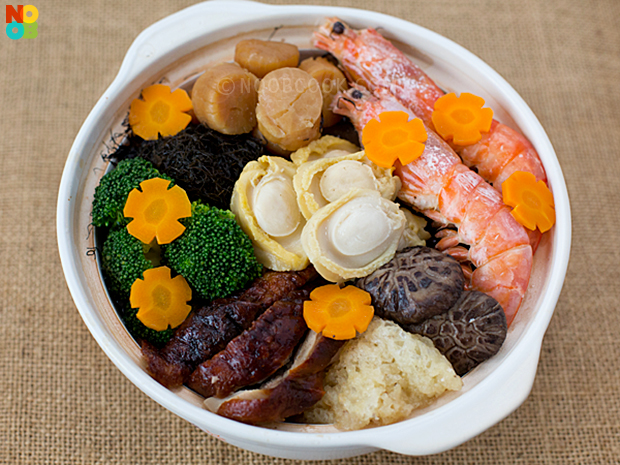
Layer 7: Top with the remaining ingredients (broccoli, abalone, prawns, carrots, roast duck, fish maw).
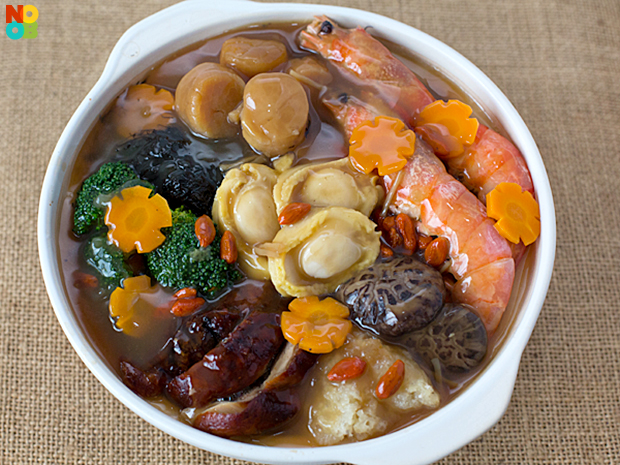
Layer 8 (last layer): Bring remaining sauce to a simmer, and while the sauce is still bubbling, pour it over the ingredients until filled to the brim. Ready!!!
Even though I used some shortcuts (store-bought fried beancurd & roast meat), it still took me 3 hours to make this dish from start to finish! Although it is tedious and time-consuming to prepare, the method is relatively easy. My cost price for the ingredients was S$100 but I believe the market rate at restaurants is easily S$300, so there is strong justification for all that hard work. The pot is also very filling and can easily be served as a one-dish meal for 6 persons (we had other Chinese New Year dishes to accompany it though), with possibly leftovers for the next day.
Pen Cai Recipe
In Pen Cai, the ingredients in the claypot are cooked separately, layered and topped with an assortment of luxurious delicacies such as abalone and conpoy. Feel free to adapt this receipe with other ingredients, e.g. sea cucumbers, roast chicken, pig skin, pacific clams.
Ingredients:
(A) Steamed Prawns
- 6 prawns veins removed with a toothpick; head and shells intact
- 1 tbsp Shaoxing wine
- ginger slices
(B) Broccoli and Carrots
- 100g broccoli florets
- 1/2 carrot, cut to flower slices
(C) Napa Cabbage, Daikon and Fish Maw
- 1/2 or 200 grams daikon (white radish) peeled and sliced to 2cm thickness, soaked in a bowl of water for 10 minutes to remove bitter taste
- 1/2 head napa cabbage ends trimmed, cut to big pieces
- 50 grams threadfin fish maw soaked in hot water until softened and puffy, drained
- 1.5 litres instant chicken stock if making your own, check out chicken stock recipe
(D) Abalone, Tau Kee, Mushrooms and Conpoy
- 1 can baby abalone reserve abalone broth
- 10 dried Chinese mushrooms rinsed and soaked in a small bowl of hot water for 15 minutes to soften (reserve soaking water); trim & discard stems
- 10 conpoy (dried scallops) rinsed and soaked in a small bowl of hot water for 15 minutes to soften (reserve soaking water)
- 50 grams dried beancurd skin/tau kee break to big pieces, then soaked in a bowl of water for 15 minutes until it turns a pale shade
- 1/2 tsp dark soy sauce for the colour; adjust accordingly to your preference
(E) Sauce
- 1/2 tbsp wolfberries, soaked in a bowl of water until puffy
- Cornstarch solution (3 tbsp cornstarch dissolved in 1 tbsp water)
(F) Others
- 2 pieces of tau kwa (deep fried bean curd/炸豆干) I bought mine ready fried from the vegetarian bee hoon stall
- quarter roast duck sliced; I bought mine from the market’s roast meat stall
- 200 grams roast pork belly sliced; if making your own, check out siu yuk recipe
- a small handful of fat choy (fa cai/发菜) soaked in a bowl of hot water for 10 minutes, drained
Directions:
(A) Steamed Prawns
Line a plate with ginger slices and arrange prawns on top. Drizzle Chinese wine. Steam for 4 minutes or until prawns are cooked. Set aside.
(B) Broccoli and Carrots
In a pot of boiling water, add broccoli and carrot slices. Blanch for 3 minutes. Take out carrots and set aside. Take out the broccoli and plunge immediately in a bowl of ice water (so that it will retain its bright green hue). Drain and set aside after 5 minutes.
(C) Napa Cabbage, Daikon and Fish Maw
Bring chicken stock to a boil. Add napa cabbage and as soon as they soften, take out and set aside (just about a minute). Add fish maw and daikon; simmer for 15 minutes or until fish maw is soft and daikon is translucent. Set aside.
(D) Abalone, Tau Kee, Mushrooms and Conpoy
- With the remaining chicken stock in the pot, blanch abalone in a slotted ladle for a few seconds until warmed. Set aside.
- Add dark soy sauce, and mushrooms/conpoy soaking water. Add mushrooms, tau kee and conpoy (use a slotted ladle to hold the conpoy so that they won’t disintegrate; see photo). Simmer tau kee for 10 minutes and take out. Set aside. Continue simmer the mushrooms and conpoy for a further 10-20 minutes, or until softened. Make sure the scallops remains intact and do not disintegrate. Any time the liquid runs dry, top up with more chicken stock.
(E) Sauce
Add abalone broth to the remaining chicken stock. Top up more chicken stock if you need more sauce. Add wolfberries and simmer for 3 minutes. Season to taste (you can use soy sauces, abalone sauce, rock sugar cubes and/or concentrated chicken stock). Thicken with cornstarch solution, a little at a time and stirring continuously, until the sauce reaches a semi-thick consistency.
(F) Assembling & Layering the Pen Cai
- Layer Pen Cai in the following order: napa cabbage(layer 1), tau kee (layer 2), daikon (layer 3), tau kwa and pork belly (layer 4), 3/4 of the fish maw (layer 5).
- Arrange fat choy, remaining fish maw, mushrooms and conpoy in a corner. Close lid and simmer for 10 minutes.
- Arrange the rest of the ingredients (abalone, prawns, roast duck, broccoli and carrots) to fill the top layer.
- Bring the remaining sauce to a boil and pour over the ingredients until the sauce is filled to the brim of the casserole.
Noob Cook Tips
- Buy the thinner type of Chinese dried mushrooms (usually the slightly pricier variety) which cooks quickly, only about 20-30 minutes. Some dried mushrooms may take a whole day to braise as they are meant for whole-day slow cooker cooking.
- Similarly, buy the premium and softer type of fish maw (I highly recommend threadfin fish maw) which softens quickly during cooking, only about 10 minutes. Ask the sales assistant for advice on the type to purchase. Some fish maw takes much longer to cook and the resulting texture is also not as good.
